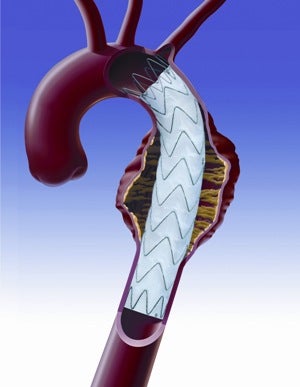
US-based Medtronic has reported that its Valiant ‘Mona LSA’ branch thoracic stent graft system demonstrated proof-of-concept in a first-in-human study being conducted under the US Food and Drug Administration (FDA)’s ‘Innovation Pathway’ early feasibility pilot programme.
The trial was conducted under investigational device exemption from the FDA and designed to demonstrate proof of principle and initial clinical safety.
The initial result from the seven-patient trial showed 100% technical success in placing the devices and 100% patency in both the main and branch grafts, with no reported type I or III endoleaks.
Carolinas HealthCare System’s Sanger Heart & Vascular Institute vascular surgeon Dr Frank Arko said the initial results of this early feasibility study are encouraging.
“This new technology could potentially minimise the need for invasive surgery and extend the benefits of endovascular repair without additional surgery to more patients with thoracic aortic aneurysms,” said Dr Arko, one of the study’s two US investigators.
How well do you really know your competitors?
Access the most comprehensive Company Profiles on the market, powered by GlobalData. Save hours of research. Gain competitive edge.

Thank you!
Your download email will arrive shortly
Not ready to buy yet? Download a free sample
We are confident about the unique quality of our Company Profiles. However, we want you to make the most beneficial decision for your business, so we offer a free sample that you can download by submitting the below form
By GlobalDataThe Valiant Mona LSA system is designed to repair a thoracic aortic aneurysm (TAA) encroaching on the left subclavian artery (LSA) by excluding the aneurysm from blood flow, while maintaining perfusion of the LSA.
It features modifications to Valiant Captivia thoracic stent graft, including a branch cuff that accommodates the left subclavian artery branch graft.
Its unique design eliminates the routine requirement for surgical LSA bypass, which proves necessary following about 40% of thoracic aortic aneurysm cases where coverage of the LSA is required to achieve a seal zone with the stent graft.
Cleveland Clinic cardiothoracic surgeon and the study’s national primary investigator Dr Eric Roselli said thoracic aortic aneurysms involving branch vessels such as the LSA can be particularly challenging to treat.
“The Valiant Mona LSA system could help address an unmet need in the treatment of thoracic aortic aneurysms,” said Dr Roselli. “This is clearly reflected in the FDA’s decision to help advance the development of this new therapy.”
The Valiant Mona LSA system was the first of nine devices selected for evaluation as part of the FDA’s new pilot programme designed to encourage early-stage clinical investigation of new medical devices in the US. The branch thoracic stent graft system is reportedly the first device of its kind to undergo clinical evaluation in the US.
According to GlobalData estimates, the US thoracic aortic stent grafts market in the US was valued at $193m in 2012 and is expected to grow at a CAGR of 6.6% to reach $302m by 2019.
Image: Valiant thoracic stent graft in Aorta. Photo: courtesy Medtronic, Inc.




